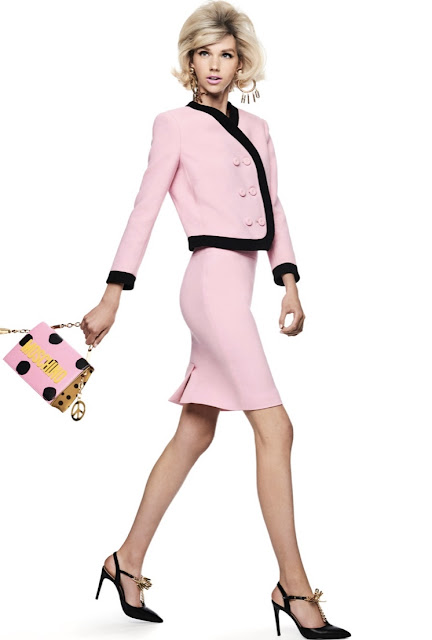Pattern plays were used throughout the collection, as seen here with polka dots and vibrant colors playfully juxtaposed against the backdrop of a traditional pant suit.
During the 1970s and 1980s, women were entering the 9 to 5 workforce into the previously male dominated offices and roles. Fashion supported women’s transition by providing suits and silhouettes that communicated authority and power. With designers like Ralph Lauren and Georgio Armami at the forefront of this wardrobe shift, a woman could select a suit to support her role as a professional equal, rather than emphasize her feminine or nurturing qualities.
Dynasty's leading ladies embodied the idea of 1980s glamour with furs, heels and glittering jewels.
By the late 1980s shows like Dynasty gave women a new model of power dressing. Big hair and big shoulders were all the rage, with plenty of glitz and glamour. And so the more modest forms of workwear embodied by the likes of Prime Minister Margaret Thatcher with pinstripes, tweeds and conservative colors were infused with new options that included pops of color, polka dots and bows. As in the picture above, the ladies of Dynasty showcased the power of a good dress and bold jewelry to communicate their position and authority.
The silky blue dress of this Dynasty leading lady got reimagined as a silky backdrop to a mixed print skirt suit.
Conflicting patterns like opposing polka dots seen above mimicked Heather Locklear's mixed animal prints worn on the show.
If the mixing of prints feels like too much, you can embrace a loud print in your accessories. That's the technique seen with the pink suit above. There is the splash of a polka dot handbag with a more conservative suit in the style of Chanel.
The classic black and white combo is elevated with jewelry pieces and a statement hat.
Runway photos: Photographed by Giampaolo Sgura for Moschino via Vogue
Dynasty photos: ABC/Photofest via Wonderwall



















